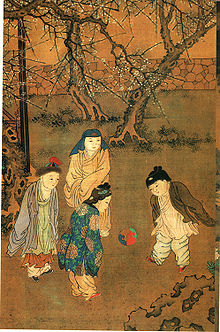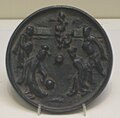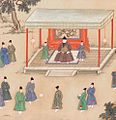Cuju
| Cuju | |||||||||||||||||||||||||||
|---|---|---|---|---|---|---|---|---|---|---|---|---|---|---|---|---|---|---|---|---|---|---|---|---|---|---|---|
 Chinese women playingcuju,byMing dynastypainterDu Jin | |||||||||||||||||||||||||||
| Chinese | Đá cầu | ||||||||||||||||||||||||||
| Literal meaning | "kick ball" | ||||||||||||||||||||||||||
| |||||||||||||||||||||||||||
CujuorTs'u-chü(Đá cầu) is an ancient Chinese ball game, resembles modern association football.[1]FIFAcites Cuju is the earliest form of a kicking game for which there is scientific evidence, a military manual from theHan dynasty.[2]
[3]It is a competitive game that involves both teams trying to kick a ball through an opening into a central hoop without the use of hands whilst ensuring the ball does not touch the ground.[4]This is similar to howhackey-sackis played today and the sport resembles a mix of basketball, soccer and volleyball. [5]Descriptions of the game date back to theHan dynasty,with a Chinese military work from the 3rd–2nd century BC describing it as an exercise.[6][7]It was also played in other Asian countries likeKorea,JapanandVietnam.[8]
History[edit]

The first mention ofcujuin a historical text is in theWarring StateseraZhan Guo Ce,in the section describing thestate of Qi.[9]It is also described inSima Qian'sRecords of the Grand Historian(under the Biography ofSu Qin), written during theHan dynasty.[10][11]A competitive form ofcujuwas used as fitness training formilitarycavaliers,while other forms were played for entertainment in wealthy cities likeLinzi.[10]
During the Han dynasty (206 BC – AD 220), the popularity ofcujuspread from the army to the royal courts andupper classes.[12]It is said that the Han emperor Wu Di enjoyed the sport. At the same time,cujugames were standardized and rules were established.Cujumatches were often held inside the imperial palace. A type of court calledju chang ( cúc tràng )was built especially forcujumatches, which had six crescent-shaped goal posts at each end.
The sport was improved during theTang dynasty(618–907).[13]First of all, the feather-stuffed ball was replaced by an air-filled ball with a two-layered hull. Also, two different types of goal posts emerged: One was made by setting up posts with a net between them and the other consisted of just one goal post in the middle of the field. The Tang dynasty capital ofChang'anwas filled withcujufields, in the backyards of largemansions,and some were even established in the grounds of thepalaces.[14]Soldiers who belonged to the imperial army and Gold Bird Guard often formedcujuteams for the delight of the emperor and his court.[14]The level of femalecujuteams also improved.Cujueven became popular amongst the scholars and intellectuals, and if a courtier lacked skill in the game, he could pardon himself by acting as a scorekeeper.[14]
Cujuflourished during theSong dynasty(960–1279) due to social and economic development, extending its popularity to every class in society. At that time, professionalcujuplayers were popular, and the sport began to take on a commercial edge. Professionalcujuplayers fell into two groups: One was trained by and performed for the royal court (unearthed copper mirrors and brush pots from the Song often depict professional performances) and the other consisted of civilians who made a living ascujuplayers. During this period only one goal post was set up in the center of the field.
It influenced the development in Japan ofkemari( đá cầu ), which is still played today on special occasions. Thekanjiwriting ( đá cầu ) is the same as forcuju. TheSilk Roadfacilitated the transmission ofcuju,especially the game popular in theTang dynasty,the period when theinflatableball was invented and replaced the stuffed ball.[15] Cujubegan to decline during the Ming dynasty (1368–1644) due to neglect, and the 2,000-year-old sport slowly faded away.
-
Bronze mirror dating to theSong dynasty
-
15th centuryMing dynastydepiction ofcuju,from a printed book of theWater Margin
-
Emperor Taizu of Songplayingcujuwith Prime Minister Zhao Pu, by theYuan-erapainterQian Xuan(1235–1305)
-
TheXuande Emperor(r. AD 1425–1435) of theMing dynastyobserving court eunuchs playingcuju
-
Kemariat play
Gameplay[edit]
Historically, there were two main styles ofcuju:zhuqiu(Trúc cầu) andbaida(Bạch đánh).
Zhuqiuwas commonly performed at court feasts celebrating the emperor's birthday or during diplomatic events. A competitivecujumatch of this type normally consisted of two teams with 12–16 players on each side.
Baidabecame dominant during the Song dynasty, a style that attached much importance to developing personal skills. Scoring goals became obsolete when using this method with the playing field enclosed using thread and players taking turns to kick the ball within these set limits. The number of fouls made by the players decided the winner. For example, if the ball was not passed far enough to reach other team members, points were deducted. If the ball was kicked too far out, a large deduction from the score would result. Kicking the ball too low or turning at the wrong moment all led to fewer points. Players could touch the balls of other players with any part of the body except their hands, whilst the number of players ranged anywhere from two to ten. In the end, the player with the highest score won.
Cujuclubs[edit]
According toDongjing Meng Hua Lu,in the 10th century, acujuleague, Qi Yun She ( tề vân xã ) was developed in large Chinese cities. Local members were eithercujulovers or professional performers. Nonprofessionals had to formally appoint a professional as their teacher and pay a fee before becoming members.[16][17]This process ensured an income for the professionals, unlikecujuof the Tang dynasty. Qi Yun She organised annual national championships known as Shan Yue Zheng Sai ( núi cao chính tái ).[citation needed]
In popular culture[edit]
- TheHong KongTVBseriesA Change of Destinyfeatures at least one episode based on thecujucompetition.Baguaconcepts were also used to jinx the opposing team. However, it followed more of the modern soccer rules than the ancient rules of the game.
- John Woo'sepic filmRed Clifffeatures acujucompetition withCao Caoand others observing from the sideline.
- The seriesThe Long Balladfeatures acujucompetition between theTang dynastyand theEastern Turkic Khaganate.
- The Korean seriesMoon Embracing the Sunfeatures achuggukcompetition.
- The Korean seriesDream of the Emperorfeatures achuggukcompetition between thehwarangand royal inspectors whilePrincess Deokmanis watching; in another sceneKim Chun-chuplays the game with his grandson.
Cujurevival[edit]
In 2010, the city of Linzi organized a game ofcujufor foreigners and locals in period costumes.[18]Brazilian playerKakáplayedcujuduring his tour while visiting China.[19]
See also[edit]
- Chinlone
- Episkyros
- Harpastum
- Knattleikr
- La soule
- Sepak takraw
- List of Chinese inventions
- List of China-related topics
Notes[edit]
- ^"Sports".Encyclopedia Britannica.Archivedfrom the original on April 17, 2021.RetrievedApril 20,2021.
- ^"Classic Football History of the Game".FIFA. Archived fromthe originalon December 25, 2012.RetrievedSeptember 17,2013.
- ^https:// fifamuseum /en/blog-stories/editorial/origins-cuju-in-china/
- ^Origins of Cuju in Chinafifamuseum
- ^https:// fifamuseum /en/blog-stories/editorial/origins-cuju-in-china/
- ^"History of Football - The Origins".FIFA. Archived fromthe originalon October 28, 2017.RetrievedMarch 29,2019.
- ^Team, Editorial (August 22, 2021)."The History Of Soccer".historyofsoccer.info.RetrievedOctober 7,2021.
- ^Barr, Adam."History of Football: Cuju".Bleacher Report.RetrievedJuly 7,2021.
- ^Zhan Guo Ce,Book 8, Strategies of Qi( tề sách ), "Lâm tri bên trong 〈 Diêu bổn lâm tri, tề bỉ. Bào bổn thuộc tề quận. Bổ rằng: Thanh Châu lâm tri huyện, cổ doanh khâu mà, thành lâm tri, cố vân. Thấy chính nghĩa cập thủy kinh chú. Bột Hải, sau ngữ Bắc Hải, nay Thanh Châu Bắc Hải là cũng. 〉 bảy vạn hộ, thần trộm độ chi, 〈 Diêu bổn độ, kế. 〉 hạ 〈 bào bổn bổ rằng: Sử vô “Hạ”. 〉 hộ tam nam tử, ba bảy hai mốt vạn, không đợi phát với xa huyện, mà lâm tri chi tốt, cố lấy 〈 bào bổn “Lấy” làm “Đã”. ○ ghi chú nay bổn “Lấy” làm “Đã”. Phi liệt án: Sử ký làm “Đã”. 〉 21 vạn rồi. Lâm tri cực phú mà thật, này dân đều bị thổi vu, 〈 bào bổn tựa sanh, 36 hoàng. 〉 cổ sắt, 〈 bào bổn tựa cầm, 25 huyền. 〉 đánh trúc, 〈 bào vốn dĩ trúc khúc năm huyền chi nhạc. 〉 đánh đàn, chọi gà, đi khuyển, sáu bác, 蹹 cúc giả; 〈 bào bổn “Cúc” làm “Cúc”. ○ Lưu hướng đừng lục, túc cúc, Huỳnh Đế làm, chỉ vì ngu diễn lấy luyện võ sĩ. “蹹”, tức “Túc” cũng. Bổ rằng: Vương dật vân, đầu sáu đũa, hành sáu cờ, gọi chi sáu bác. “蹹”, sử làm “Đạp”. Nói văn, đồ hạp phản, tức “蹹” tự. Ghi chú phi liệt án: Sử ký làm “Cúc”. "
- ^abRiordan (1999), 32.
- ^Records of the Grand Historian,Biography of Su Qin( tô Tần liệt truyện ), "Lâm truy cực phú mà thật, này dân đều bị thổi vu cổ sắt, đánh đàn đánh trúc, đấu gà chó săn, sáu bác đạp cúc giả."
- ^"The History of Soccer - History of the Game".Archived fromthe originalon April 23, 2008.RetrievedAugust 6,2008.
- ^"Star Wars tops Xmas toy list".msn.Archived fromthe originalon August 9, 2008.RetrievedAugust 4,2008.
- ^abcBenn, 172.
- ^Yang, Lin (2018). "Chinese Ju and World Football".Advances in Social Science, Education and Humanities Research.120:276–281.
- ^Vogel, Hans Ulrich (January 2012)."Homo ludens sinensis: Kickball in China from the 7th to the 16th Centuries".Vivienne Lo (Ed.), Perfect Bodies, Sports, Medicine and Immortality, Pp. 39-58.RetrievedJuly 7,2021– via academia.edu.
- ^"Từ cao cầu phát tích nói nói thời Tống đá cầu cùng tề vân xã".sohu.RetrievedJuly 7,2021.
- ^"Cuju, archetype of modern game of football".chinadaily.cn.RetrievedJuly 7,2021.
- ^"Kaka plays ancient Chinese soccer in 'hanfu' (1/5)".ecns.cn.RetrievedJuly 7,2021.
References[edit]
- Benn, Charles (2002).China's Golden Age: Everyday Life in the Tang Dynasty.Oxford: Oxford University Press.ISBN0-19-517665-0.
- Riordan, James (1999).Sport and Physical Education in China.London: Spon Press.ISBN0-419-22030-5
- Osamu Ike (2014).Kemari in Japan(in Japanese). Kyoto: Mitsumura-Suiko Shoin.ISBN978-4-8381-0508-3
- Summary in English pp. 181–178. in French pp. 185–182.
External links[edit]
![]() Media related toCujuat Wikimedia Commons
Media related toCujuat Wikimedia Commons








